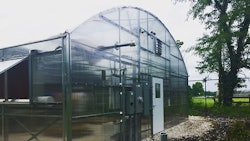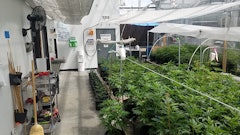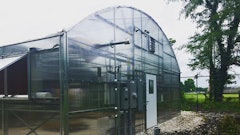
Planning the appropriate ventilation system for a greenhouse can be difficult, whether for a new structure or a retrofit. The proper airflow for a healthy cannabis crop looks different than it does for some ornamental and produce crops, and it’s important to get it right, says David Bonvillain, founder and CEO of Elite Cannabis Enterprises in Colorado. Here are his tips to keep the air moving for a strong grow.
Go bigger.
Cannabis requires much heavier airflow than more traditional greenhouse crops, says Bonvillain, and some manufacturers will need guidance to reach the right mark. At a greenhouse in Missouri, plants couldn’t get adequate airflow from fans attached to the water wall unit because the design was optimized for an ornamental crop. The system was sized at 115 percent of what the manufacturer usually scoped for ornamentals, but should’ve been even five or six times larger than that, says Bonvillain.
“It’s a very different climate … I take the plant all the way through its lifecycle. I have a mature fruit,” says Bonvillain. “In those kinds of climates, I need significantly more airflow. I need not only air that’s coming through just my water wall and out the back evacuation. I need circulating airflow through the entire environment at a pretty good clip.”
Keep air moving both high and low.
Airflow needs to circulate within a grow, and that means paying as much attention to the lower currents in the room as the upper ones. Upper channels of air help regulate the overall temperature, but a lower channel of air gets cooler air down to where moisture and heat pockets are sometimes trapped by the canopy. It takes a balance of both, which means specific planning beyond a typical greenhouse design, says Bonvillain.
“I need channels of air on a low zone so I’m moving air around the lower canopy. If you don’t, you increase your chances of mold and mildew and pests significantly,” says Bonvillain. “Then I also need canopy movement above the plants that keeps all the air circulating.”
Plan for power and look for leaks.
One major issue for air movement, especially in a retrofit structure, is power supply, says Bonvillain. Look at the energy available to the structure, and whether it supplies enough for the other systems as well as the air, such as supplemental lighting. A retrofit greenhouse could have an appropriate amount of available energy to handle an ornamental grow’s systems, but not nearly enough for a cannabis crop.
“First thing I would [look at is] power,” he says. “The power is going to define what you can really supply into the greenhouse for air movement.”
Another special concern for a retrofit greenhouse is how tightly sealed it is, both to outside air and outside light. Many traditional nurseries aren’t sealed as securely as a cannabis grower requires to keep out pests and other outside dangers to the grow, says Bonvillain. Be certain that light-deprivation curtain material allows air to circulate, or plan appropriate ventilation for those events. But especially when it comes to sidewall material, the wrong material or a leak could be disastrous.
“If you’re doing light deprivation and you don’t have solid sidewalls, the light pollution can generally destroy your crop,” says Bonvillain.
Go bigger.
Cannabis requires much heavier airflow than more traditional greenhouse crops, says Bonvillain, and some manufacturers will need guidance to reach the right mark. At a greenhouse in Missouri, plants couldn’t get adequate airflow from fans attached to the water wall unit because the design was optimized for an ornamental crop. The system was sized at 115 percent of what the manufacturer usually scoped for ornamentals, but should’ve been even five or six times larger than that, says Bonvillain.
“It’s a very different climate … I take the plant all the way through its lifecycle. I have a mature fruit,” says Bonvillain. “In those kinds of climates, I need significantly more airflow. I need not only air that’s coming through just my water wall and out the back evacuation. I need circulating airflow through the entire environment at a pretty good clip.”
Keep air moving both high and low.
Airflow needs to circulate within a grow, and that means paying as much attention to the lower currents in the room as the upper ones. Upper channels of air help regulate the overall temperature, but a lower channel of air gets cooler air down to where moisture and heat pockets are sometimes trapped by the canopy. It takes a balance of both, which means specific planning beyond a typical greenhouse design, says Bonvillain.
“I need channels of air on a low zone so I’m moving air around the lower canopy. If you don’t, you increase your chances of mold and mildew and pests significantly,” says Bonvillain. “Then I also need canopy movement above the plants that keeps all the air circulating.”
Plan for power and look for leaks.
One major issue for air movement, especially in a retrofit structure, is power supply, says Bonvillain. Look at the energy available to the structure, and whether it supplies enough for the other systems as well as the air, such as supplemental lighting. A retrofit greenhouse could have an appropriate amount of available energy to handle an ornamental grow’s systems, but not nearly enough for a cannabis crop.
“First thing I would [look at is] power,” he says. “The power is going to define what you can really supply into the greenhouse for air movement.”
Another special concern for a retrofit greenhouse is how tightly sealed it is, both to outside air and outside light. Many traditional nurseries aren’t sealed as securely as a cannabis grower requires to keep out pests and other outside dangers to the grow, says Bonvillain. Be certain that light-deprivation curtain material allows air to circulate, or plan appropriate ventilation for those events. But especially when it comes to sidewall material, the wrong material or a leak could be disastrous.
“If you’re doing light deprivation and you don’t have solid sidewalls, the light pollution can generally destroy your crop,” says Bonvillain.















